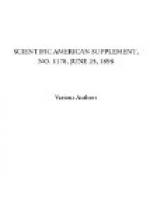The “SCHLAMM,” or mud, thrown down from the water of coal washing has hitherto been regarded as worthless, says The Engineering and Mining Journal, except that sometimes a portion of the coal particles it contained have been separated and made of value by a washing process; but Bergassessor Haarmann, of Friedrichsthal, has invented a new method for treating it dry and dividing it into two products, one of which, with low ash content, is distinguished by its granular nature, while the other contains a large proportion of ash and is of the fineness of flour. The former of these two products is, on account of its low ash content, useful for various purposes, and the latter constitutes a fuel quite ready for use in coal dust firing. The method is founded on the circumstances, hitherto lost sight of, that the incombustible constituents of the “schlamm” chiefly consist of clay which was formerly more or less dissolved in the wash water; and on the mud being dried and subjected to a suitable mechanical process, the clay falls into fine dust, while the coal particles, on the contrary, retain their granular nature. The method is carried out by drying the mud and a subsequent fine sifting, which effects a breaking up of the lumps that occur in the dried “schlamm,” and a separation into the two products above named. The dust that falls through the sieve has a high ash content, being in the nature of flour, while what remains behind is granular and has a low ash content. It seems to us that this game is hardly worth the candle.
* * * * *
ELECTRICAL NOTES.
Electricity at the Paris Exposition.—Electricity will play a large part at the Paris Exposition of 1900, says the Revue Technique. No less than 15,000 h.p. will be used for lighting and 5,000 h.p. for furnishing electric power to the various parts of the grounds. As far as possible all the machinery exhibited will be shown at work and for this purpose electric conductors will be laid down to all points on the grounds. The boiler plant will be located at the end of the Champ de Mars, and will occupy two spaces of 130 X 390 feet each, one being devoted to French boilers and the other to those of foreign makers. This plant will be in itself a very interesting exhibit. It is proposed to provide a capacity for evaporating not less than 440,000 pounds of water per hour.




